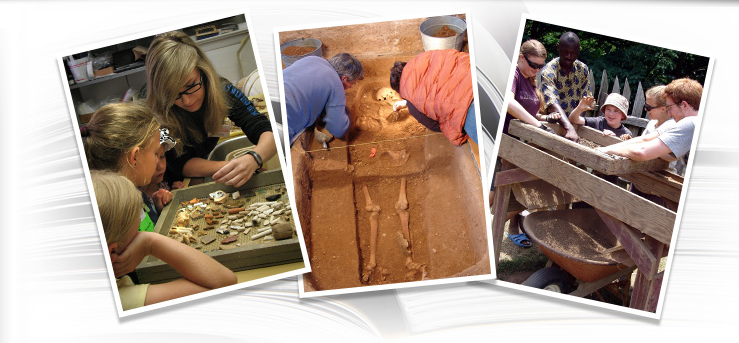2013 Week 7
As seems usual this summer, we began most days this week with a little physical exercise by bailing rain from the units.
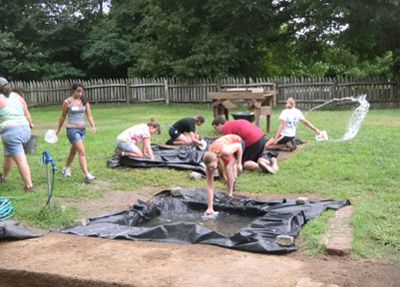
Bailing water from the units.
The white objects that all the students are using to move the water are gallon milk jugs that have had their bottoms cut off. These provide cheap, flexible containers for this purpose. This week we lost another two days to rain and spent more time recovering from the rain. With so little field time left, every hour counts if we are to accomplish our goals.
In an earlier dispatch, I discussed the fence cutting across what we thought was a cellar. As it turns out, this feature was actually two fences that come together just to the west of the cellar feature. This can be seen in the profile drawn on the west side of the excavated trench.
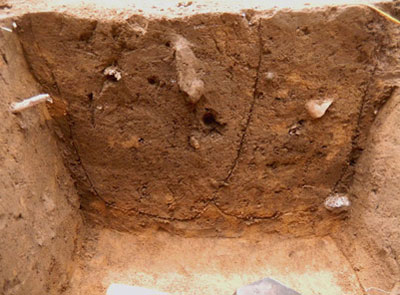
Profile of two paling fences.
The edges of the trench were expanded slightly in order to show both sides of the fences. Both fences were less than a foot wide at the top and narrowed near their rounded bottoms. The fence on the right was the original fence and the one on the left replaced it. This is evident because of the way one cuts into the other. It does not tell us how much time elapsed between these two events just their relationship. Neither of the fences has much in it to help date them either.
The biggest surprise from the fence excavations was the realization that the feature we thought to be a cellar must be some other kind of feature.
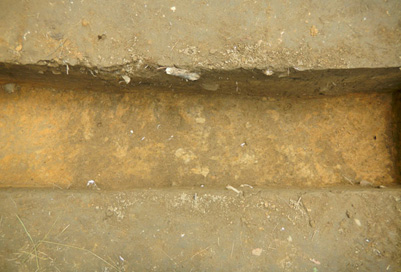
Feature at the bottom of the fence line.
The biggest surprise from the fence excavations was the realization that the feature we thought to be a cellar must be some other kind of feature.
When first seen, this feature was a very dark, large circle, about 8 feet in diameter. It was assumed that this represented a smaller hole whose upper edges had eroded, creating the circle. At the bottom of the fence trench however, the dark soil narrowed to a very mottled soil which is, at most, three feet across. Until we can see this whole feature, we can only scratch our heads about its function or date. Over the next week, we hope to expose this feature and gain a better understanding of it.
Another “cellar” feature we are set to explore is located in the northern half of the Calvert House.
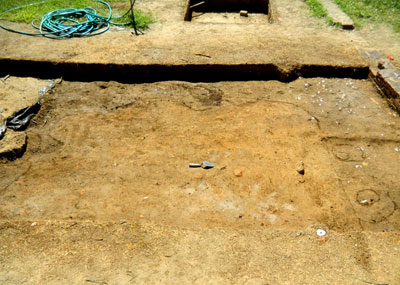
Large, rectangular feature which might hide a chimney base.
Throughout most of the summer, this area was so incredibly dry that it was hard to identify any features. At one point, I put a sprinkler in the center of the excavation and just let it run for a couple of hours, with very little effect. The only good thing about all the rain we have had is that it has made this area workable. We were able to define a large, rectangular feature which contains a sandy fill containing a large amount of brick. When first seen in the 1980s work, this was thought to be a cellar. It is also possible that this was the location of the original chimney in this portion of the house. Over the next week, we will test this feature. In preparation for this work, I cored the feature to see how deep it might be. The core went through 1.1 feet of sandy fill before it encountered subsoil. This suggests that the feature is relatively shallow.
Because of the rain and the nature of the work we completed this week, we did not find very many artifacts. Nevertheless, some of what was found was interesting. Along the south side of the site, nearer to the ravine, we have been finding quite a lot of material from the Brome house occupation.
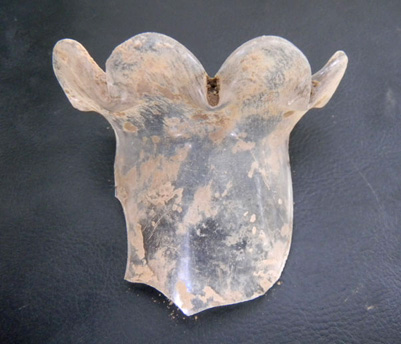
Lamp glass dating to the 19th century.
The photo shows a large piece of lamp glass typical of the 19th century. The fact that it is such a large piece indicates that this area has been undisturbed for some time.
From another part of the site, we collected most of the pieces of an 19th-century elbow pipe.
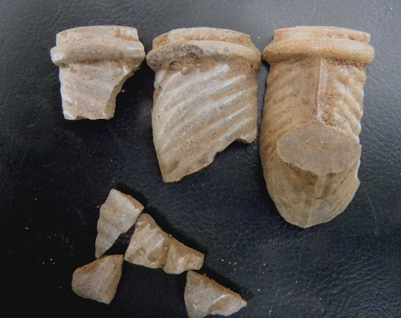
Clay pipe from the 19th century.
Unlike 17th-century pipes, this had a short stem which the smoker completed by adding a hollow reed. This not only made the pipe cheaper but it tended to last longer as well. The example here has a molded decoration on the bowl.
Also, we found another piece of beautifully decorated 17th-century ceramic.
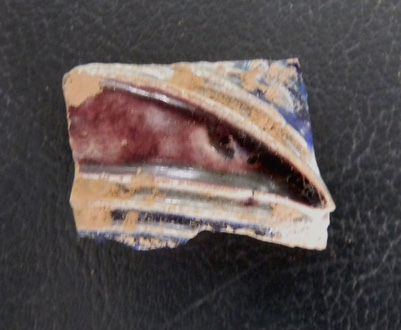
Sherd of Rhenish blue and gray stoneware.
This is a type known as Rhenish blue and gray stoneware. It comes from Germany and was probably part of a jug used for wine. In addition to the normal blue, this has manganese added to produce the purple color and has incised decoration, indicating that it dates to the late 17th century. We have been finding quite a lot of this type of ceramic.


